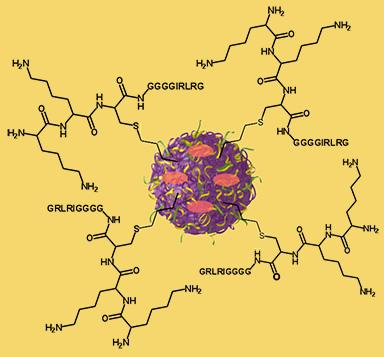A system for releasing an anti-cancer drug, based on an innovative material known as a nanosponge, is three to five times more effective in reducing the development of a cancer tumor than direct injection

"Efficient systems for the targeted transfer of drugs have been a desired goal for a long time, but their development has been delayed due to the complex chemistry involved," said researcher Eva Harth, professor of chemistry at Vanderbilt University, who developed the innovative transfer system. "We have been able to make serious progress in overcoming these bumps."
To understand the new system, imagine preparing tiny swabs, the size of a virus, filling them with the desired drug and linking unique chemical compounds to it that preferentially react with chemical groups found only on the surface of cancer cells, and then injecting them into the patient. The tiny sponges flow through the bloodstream until they encounter the surface of a cancer cell and at this point they "anchor" it (or penetrate it) and begin to release their active charge in a controlled and measured manner.
Targeted transfer systems of this type have a number of advantages: since the drug is released into the cancer cells and is not dispersed in the various body systems, its effectiveness, relative to the dose, should be higher. Also, it should produce fewer harmful side effects since smaller amounts of the drug reach, if at all, healthy tissues.
"We call the material a nanosponge, but it is actually more like a network or a three-dimensional scaffold," explains the researcher. The skeleton of the material is long chains of the polyester polymer. The polymer is mixed in solution with small particles called cross-linkers that function like tiny connecting hooks to connect different parts of the polymer together. The final result is obtaining spherical particles filled with cavities, inside which the drug particles can be stored. The polyester is biodegradable so that it gradually breaks down inside the body. In the process of this disintegration, he releases the medicine which he carries in predetermined doses.
"Measured release is one of the most important advantages of this system compared to other transfer nanosystems currently under development," the researcher notes. When they reach their destination, many of the other systems discharge most of their drug in a rapid and uncontrolled manner. This behavior is known as the "burst effect" and it makes it difficult to determine the exact doses of the drug.
Another important advantage is that the nanosponge particles are soluble in water. Wrapping the anti-cancer drug in a nanosponge allows the use of hydrophobic ("water-repellent") drugs that are not soluble in water. Today, these drugs must be mixed with an additional chemical, called an adjuvant, which may reduce the effectiveness of the drug and cause harmful side effects.
In addition, the size of the nanosponge particles can be controlled - by changing the ratio between the polymer particles and the connecting particles, the size of the particles can be increased or decreased. This fact is important since research has shown that drug delivery systems work optimally when their size is less than a hundred nanometers - roughly the depth of the grooves on the surface of a CD. The particles used in the current study were fifty nanometers in size. "The dependence between the size of the particle and the efficiency of its activity is the focus of vigorous research," notes the researcher.
The other important advantage of the innovative system lies in the simple chemistry required for its preparation. The researchers developed simple and highly efficient synthesis methods for the preparation of these nanoparticles and for linking the linkers composed of peptides. "Many of the other drug delivery systems require the use of complex chemistry that makes it difficult to transfer production to an industrial and commercial scale," says the researcher.
